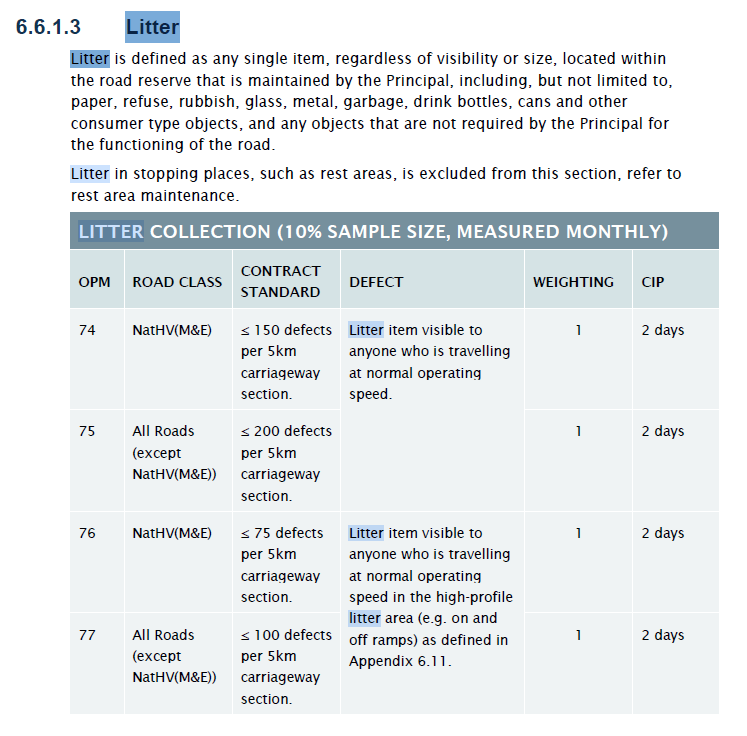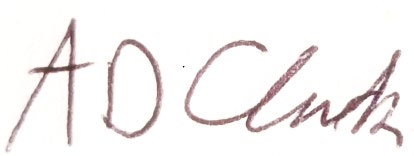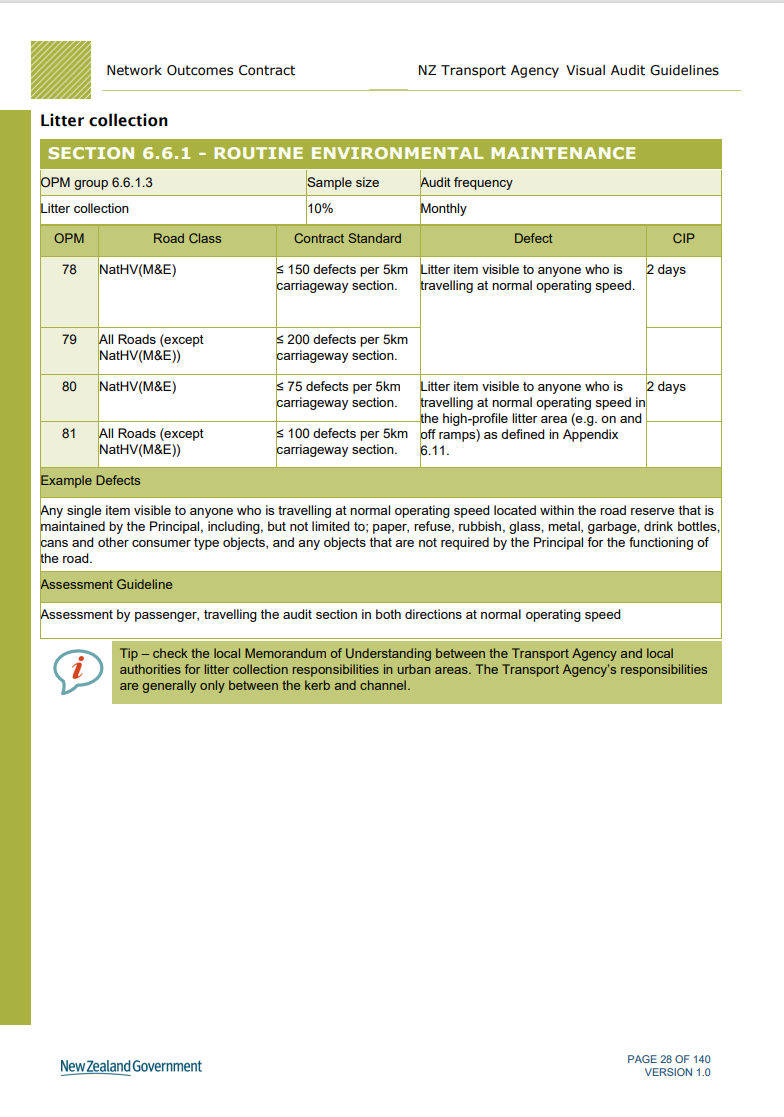
44 Bowen Street
Private Bag 6995
Wellington 6141
New Zealand
T 64 4 894 5400
F 64 4 894 6100
www.nzta.govt.nz
12 August 2024
Geoff Edwards
[FYI request #27619 email]
REF: OIA-15893
Dear Geoff
Request made under the Official Information Act 1982
Thank you for your email of 15 July 2024 requesting information under the Official Information Act
1982 (the Act) regarding the NZ Transport Agency Waka Kotahi (NZTA) obligations with respect to
roadside litter.
I wil answer each of your questions in turn below:
Policies/procedures as to how the agency meets its obligations under the NZ Litter Act 1979 to
ensure roads are cleared and kept clear of litter.
Under the NZ Litter Act 1979 (the Litter Act), litter control powers and duties are upheld by public
authorities. NZTA is recognised as one of the public authorities alongside territorial authorities such as
district, regional, and city councils.
Under Section 5 of the Litter Act, public authorities (such as NZTA) are able to appoint litter control
officers and litter wardens independently or in partnership with other public authorities to uphold these
powers and duties within a designated district or area.
Public authorities have responsibilities to undertake litter control through various mechanisms such as
providing receptables for waste in public places, standards/requirements for landowners to clear litter,
and the ability to implement by-laws to uphold litter standards. Further responsibilities upheld by public
authorities include infringement notices, offences & penalties, and special powers of convicting court.
The purpose of the act is to make better provision for the abatement and control of litter. However, it
does not place a responsibility on government organisations to col ect litter.
NZTA contracts out the litter collection work as a part of the total network maintenance activities which
are delivered under our Network Outcomes Contracts. Within these contracts, litter is defined in the
following extract from one of our standard maintenance specifications:
Litter
Litter is defined as any single item, regardless of visibility or size, located within the road
reserve that is maintained by the Principal, including, but not limited to, paper, refuse, rubbish,
glass, metal, garbage, drink bottles, cans and other consumer type objects, and any objects
that are not required by the Principal for the functioning of the road. A Litter item is defined as
one being visible to anyone who is travelling at normal operating speed. On Motorways and
expressways there is a tolerance of 75 items of litter within a 5-kilometre audit section and 100
items per 5-kilometre section for other highways. This latter standard equates to one piece of
litter every 100 meters on both side of the road.
Please note that if the litter is not visible from the road, then it is not classified as a defect. For a visual
understanding of what is considered acceptable and defect, please refer to the extracts of the Visual
Audit Guideline examples on page 5 and 6 of the response.
What standards the Agency uses to determine whether a road is adequately cleared of litter or
not.
Where the agency has contracted out litter picking to sub-contractors, I would like all available
information as to who these contractors are around NZ, what expectations/obligations are
placed on them by the Transport Agency and what measures the Agency has in place to
ensure these contractors are meeting their end of the contract.
The standards used to determine the degree of litter collection for NZTA contractors is implemented
through NZTA’s Network Maintenance contracts. Within these contracts, litter is defined as any single
item with a dimension greater than 100mm, within the road reserve that is maintained by the
contractors. NZTA ensures that a road is adequately cleared of litter through Operational Performance
Measures (OPMs), which takes a monthly audit in each network, sampling 10% of the area. This is
scored against all other OPMs within the site.
Failure to comply with these requirements incurs penalty points for the Contractor. These are
aggregated with points scored against other maintenance activities and if the total breaches
contractual thresholds lead to significant payment deductions for the contractor.
For a map of our Maintenance Contractors according to region/area, please refer to the link attached.
https://www.nzta.govt.nz/roads-and-rail/highways-information-portal/technical-disciplines/network-
outcomes-contracts/resources-and-manuals/noc-supplier-maps/ Please note that these organisations may collect the litter themselves or they may, at their discretion,
engage subcontractors to do it on their behalf. Should you have specific concerns with litter in a
particular area, please contact the NZTA Contact Centre on 0800 444 449.
Besides the appointment of litter control officers and litter wardens, NZTA does not contract out litter
maintenance activities. However, through our Network Maintenance contracts, NZTA contractors are
expected to pick up litter from roadsides and rest-areas. Often, other public authorities wil also pick up
litter on behalf of NZTA in urban areas of the State Highway Network through a Memorandum of
Understanding as upheld by NZTA’s regional Maintenance and Operations teams.
2

For example:
NZTA 1878 Taranaki NOC v3, showing the maintenance specification of 6.6.1.3 Litter Specification.
Any information pertaining to the health and safety policies that exist around the picking of
litter on state highways.
To ensure that all road workers and users are able to have the best protection possible from
workplace health and safety risks, NZTA currently requires its contractors to adhere to the Code of
Practice for Temporary Traffic Management (CoPTTM). CoPTTM provides guidance to aspects of
temporary traffic management. Section A, page 11 of the COPTTM notes the Litter Act 1979 as a
relevant act to be adhered to. On Section D, page 49, the CoPTTM provides an outline of the basic
requirements to carry out road maintenance activities, such as the removal of litter. NZTA has recently
updated its temporary traffic management guidance and wil soon be updating our contracts to refer to
the NZ Guide to TTM (NZGTTM) in place of CoPTTM.
To read more about the CoPTTM, please refer to the link attached:
https://www.nzta.govt.nz/assets/resources/code-temp-traffic-management/docs/2018/sections-a-to-h-
combined-copttm-4th-ed-nov2018.pdf To read more about the NZGTTM, please refer to the link attached:
https://www.nzta.govt.nz/assets/Roads-and-Rail/nzgttm/docs/New-Zealand-guide-to-temporary-traffic-
management.pdf
3

If you would like to discuss this reply with NZTA, please contact Ministerial Services by email to
[NZTA request email].
Yours sincerely
Andrew Clark
National Manager, Maintenance & Operations
4
 Extract Visual Audit Guidelines
Extract Visual Audit Guidelines
5

6





